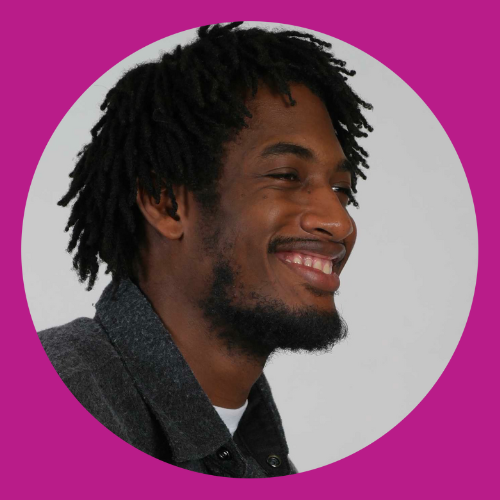When teachers and teaching artists collaborate, something magical happens in classrooms
/Frank Sentwali
Spoken Word Teaching Artist
“This week was magical!”
Have you ever heard a kid say something like this in reference to their time at school? We have. It was the result of a partnership between a teacher and a teaching artist, a collaboration capable of producing transformational success for multiple generations of students.
We recently heard about two such partnerships from teachers who have worked for many years with COMPAS Teaching Artist Frank Sentwali. What they shared about their collaborations with him and their perspective on the value of working with teaching artists was both moving and thrilling.
Michelle Heller began working with Frank when she was teaching a fifth-grade class and wanted to strengthen an upcoming poetry unit by exposing her students to a different kind of poetry. She also wanted to provide an opportunity for them to work with a teacher of color. The residency was so successful she has continued inviting Frank back every year since, estimating that he’s worked with her classes eighteen times over the last twenty years. “He is so special and great at what he does,” she shared. “I noticed right away that there was strong relational capacity. Frank has the ability to build relationships with students from the first day he steps into a classroom. He gains their trust quickly and easily. He gets down to their level. He understands what students are going through, and they immediately grasp onto him.”
Deb Hansen, a teacher who has known Frank for fifteen years and worked with him for fourteen of them, shared a similar perspective about the impact he has on a classroom. “Frank has very high expectations of the students. He encourages them to go for the stars and is a dynamic, strong presence in the classroom.”
Both Michelle and Deb noted that when students work with Frank, they feel like their voices are heard in a different way, one that improves their confidence and validates their self-worth. “Frank brings out in students their vulnerabilities, which you don’t often see in middle schoolers,” Deb said. “I’ve had students who created poems that were so vulnerable, but they were willing to take a risk when Frank was here that week, which blew my mind.”
“The students have an opportunity to have their voices heard in a different way, and they’re encouraged to truly speak their mind,” Michelle commented. “Frank shares his vulnerability with the class through his spoken word. Then, he gets that back from them. He shares stories with the students and relates to them. The students want to meet his high standards, and they know that he expects a lot out of them, and they want to rise to those expectations.
When asked about his perspective on the value he provides, Frank explained: “I’m the child of educators. I’ve been around lesson plans and classroom management my whole life. I’m very specific about which education standards my program meets. There’s a real education component in my programs and then a real developmental component that comes into the craft itself. I think teachers appreciate my way of being able to connect with classrooms in a very short window (residencies last a week) and leave a lasting impact on those kids. I’ve heard stories from teachers about students who have hardly spoken to each other all year long, and now they’re having conversations like they are best buddies after hearing each other’s spoken word pieces.” He added, “Spoken word has so many values that are both academic and developmental and so intrinsic for the students that they don’t realize they are going through a transformation until they’ve gone through the whole process. But the teachers who’ve worked with me year after year see the immediate impact and how it changes classroom dynamics.”
Speaking of stories, Deb, Michelle, and Frank all shared inspiring anecdotes about individual students who were profoundly impacted by Frank’s work in their classrooms.
Deb
“There was a student who had been pretty depressed all year long and was not engaged. He was able to find his voice. He wrote a poem that was very personal to him that touched on his culture. He read it to the class with a lot of emotion. Then we went on to have an assembly for the whole 9th grade in the auditorium, and he got up and read that poem again for the whole school. Since then, he has been much more engaged in school, participating and connected, and has felt seen. I’ve worked with Frank for 15 years, and that has happened every year.
There are also so many kids every year that come out. One year, a student was struggling with her sexuality, and she came out in her poem in class while performing it. She said she finally felt safe enough to share it with the class. I remember thinking, ‘Oh my God. Did she just come out to us?’ Every year. Every class. There’s always something like that.”
Michelle
“One student who had been quiet throughout the school year created a poem about the vulnerability of being in 8th grade. He expressed how he was afraid of being made fun of and how that fear had kept him from speaking up in class. With Frank’s encouragement and support, the student shared the poem with our class. I was amazed by what he shared, and it was clear that Frank’s conversations with the student had played a key role in helping him find the confidence to speak up.”
Frank
“This is an anecdote that was shared with me. Years ago, I worked in a classroom, and there was a student who was super anxious and terrified, had stage fright, the whole nine. Very quiet and reserved student in general. The teacher and I were really wondering whether this student was going to be able to pull it off (sharing her poem with the class), but we didn’t want to give her the opt-out until the absolute last possible minute. The student ended up performing her piece. The next year, when I came back to work at the school again, that kid was one of the most gregarious and outspoken students in the class. The teacher said, ‘Yeah, ever since she stood on that stage, she’s been a different child.’ Her whole classroom demeanor changed. Her communication skills, her confidence in herself, everything just skyrocketed up. Then, come to find out, that student moved on to high school and ended up joining the debate and speech teams. And then, even later in life, she went on to college and eventually worked in international law. So that kid went from being a kid who wouldn’t talk to being a kid (and adult) who wouldn’t stop talking!”
Transforming from a child who couldn’t speak into an adult who’s comfortable speaking to the world? Now, that’s magical!
If you’d like to learn more about how a teaching artist can energize your classroom, organization, or community, we’d love to help. To get the conversation started, just fill out this form or shoot us an email at info@compas.org.





